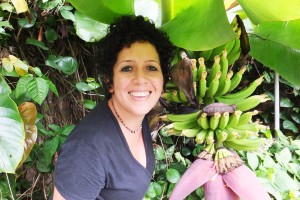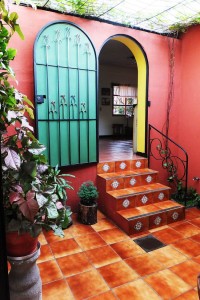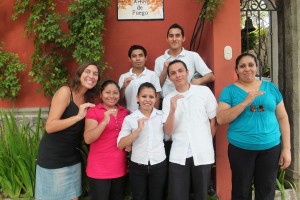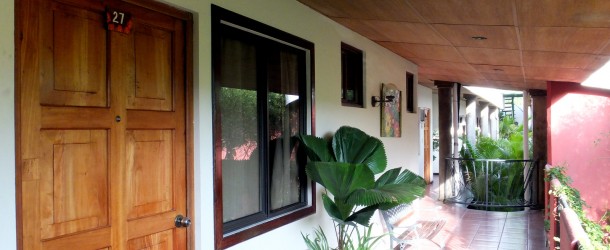Welcome to Salvador by my side! I just stayed one week in Salvador, but I’ve met the hotel that is considered as the best example in sustainable development by the national tourism ministry. So, despite brief it was an intense stay where I learnt a lot thanks to Carolina and the nice study case of her Eco-Hotel Arbol de Fuego.
A story of women
 After the hotel Mayan Secret in Mexico, here is another success story of a company created by two women, this time salvadorian. I take you with me to the Salvador capital, into a small peaceful block of this big city. When I say peaceful I mean not only in terms of safety, but also because of the zen and green environment of this little tropical oasis.
After the hotel Mayan Secret in Mexico, here is another success story of a company created by two women, this time salvadorian. I take you with me to the Salvador capital, into a small peaceful block of this big city. When I say peaceful I mean not only in terms of safety, but also because of the zen and green environment of this little tropical oasis.
Back to 2001, Carolina’s mom opened a Tea House: baby-showers, birthday parties, hen parties, it was above all a place where all kind of small events were taking place. But while she was taking a restaurant and hotel management course, Carolina’s mom started to get to know a few hotel managers, and it started to inspire her… Her tea house was located just next to the BUCA university which needed regularly accommodation for teachers and professional lecturer. With a little help of Carolina’s grand mom (who conceded them the site near the tea house) the 5 rooms guesthouse ‘Arbol de Fuego‘ was born. Arbol de Fuego is the species name of the red-and-orange-flowers-tree which welcomes you at the hotel’s doorstep. Since the beginning of this hotel adventure, Carolina’s family always valued a lot environmental consciousness. A value which was going to give birth a few years later to a really, truely and innovative 16 rooms Eco-Hotel concept in Salvador.
Energy efficiency to overcome the crisis
 In 2008, the economic crisis didn’t spare Salvador. In addition the hotel had to face an escalating energetic consumption. It was in this context that the United States Agency for the International Development (USAID) attended by the local NGO – BUN-CA came to help out the hotel (managed already by Carolina) with a energy efficiency assessment of the property.
In 2008, the economic crisis didn’t spare Salvador. In addition the hotel had to face an escalating energetic consumption. It was in this context that the United States Agency for the International Development (USAID) attended by the local NGO – BUN-CA came to help out the hotel (managed already by Carolina) with a energy efficiency assessment of the property.
This expert team finally brought out 20 recommendations, and the hotel implemented 18 of them within the 9 months that followed. The results were impressive: the electricity consumption reduced by 38%, and the bill by 60%. And that was just the beginning. Arbol de Fuego continued on this trend and developed a numerous set of innovative measures. It became the country’s pioneer hotel and even won numerous awards. Carolina was invited by the Minister to talk about her experience in conferences on sustainable tourism throughout the continent.
The hotel had just recenlty received a new award with a $30.000 USD price to go ahead with a second project: replace all air-conditioner units, create green vegetal roofs and improve ceilings, windows and walls isolement. Nowadays this 16 rooms hotel consumes the same energy as a salvadorian family of 6 people. Once the phase of reducing a maximum energy consumption will be completed, the hotel is going to start the 2nd phase, which is energy production… and try to reach energy auto-sufficiency.
Thanks to the policy of energy efficiency, Arbol de Fuego managed to keep all its employees despite the crisis. And moreover, this strong positioning and innovative practice represent a wonderful marketing opportunity.It makes the hotel famous through media, and then free advertisement.
I invite you to discover on Hopineo.org the complete list of Arbol de Fuego environmental best practice.
A very studious stay for Miss Florie
 Just when I arrived on Monday, Carolina was entering at the hospital. Luckily it is nothing too serious but she was not going to leave the hospital until the following Thursday afternoon. Meanwhile, I enjoyed a good internet connection (that even works on the terrace) to look into the documents that explained in detail all the environmental good practice of the hotel. To my great pleasure I learnt a lot of things! I managed also to take the time to write a few new articles realted to marketing problematics that each hotel where I stay is usually facing. These articles can be used by Arbol de Fuego as well as by past hotels where I have already been and by future hotels where I am about to go:
Just when I arrived on Monday, Carolina was entering at the hospital. Luckily it is nothing too serious but she was not going to leave the hospital until the following Thursday afternoon. Meanwhile, I enjoyed a good internet connection (that even works on the terrace) to look into the documents that explained in detail all the environmental good practice of the hotel. To my great pleasure I learnt a lot of things! I managed also to take the time to write a few new articles realted to marketing problematics that each hotel where I stay is usually facing. These articles can be used by Arbol de Fuego as well as by past hotels where I have already been and by future hotels where I am about to go:
- Tips for a great hotel website
- 5 essential hotel maketing strategy steps
- What is your hotel customer segmentation?
- Which channel manager choosing?
- How to better manage your hotel’s newsletter?
Afterwards, at night, I usually had dinner with three Americans guest of the hotel. They worked for a local NGO (TechnoServe) in hunt for solutions to the strong coffee production declining throughout the country.
Tomorrow I’m already leaving Salvador in direction of Honduras as I am going to meet a good friend of mine! Santi is Argentinian and was my flatmate in Barcelona. He is in Tegucigalpa (Honduras capital city) for 2 weeks with its work. He is going to welcome me tomorrow evening at his hotel (the 5* Intercontinental!) and with a sweet plan: we’ve got a car and a personal driver to go discovering the surroundings of the capital, nice, isn’t it?! Not too bad, isn’t it?! And next Monday I will then go to the Casa Xochicalco B&B for a new hotel mission!
My stay in Salvador has been very short and I haven’t seen a lot of the country. But I somehow managed to make a 3 day stop-over in the small town of Santa Ana (between Guatemala and San Salvador) where I climbed up to the top of its vulcano (which is still active) and tasted the gastronomic specialities of its local market (all forms of “pupusas”). All the pictures here!
It is often said that Salvador is the most dangerous country of Central America (along with Honduras)… I have taken a public bus and walked through the central streets of Santa Ana and San Salvador at night… And I have never felt any kind of danger. Well, my stay was really brief and I was mainly in hotels and youth hostels. When talking to local people, I was often told that there is crime and gangs wars, but nothing really happens to tourists (who are a minimum cautious and who don’t go off the beaten tracks). Salvador is a country with magnificent beaches for surfers (I didn’t go but they have a big reputation, like the Tunco Beach), and with numerous natural parks benefiting from an incredible wildlife and flora. If you are willing to experience it, don’t hesitate to contact Raul fromLive Experience, for example, and you won’t be disappointed!
Translated by Margarida Marinho


